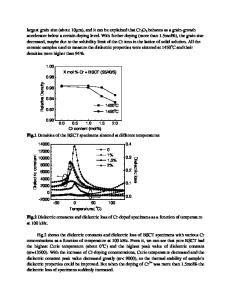Ordering and microwave dielectric properties of Ba(Ni 1/3 Nb 2/3 )O 3 ceramics
- PDF / 361,543 Bytes
- 8 Pages / 612 x 792 pts (letter) Page_size
- 28 Downloads / 368 Views
MATERIALS RESEARCH
Welcome
Comments
Help
Ordering and microwave dielectric properties of Ba(Ni1/3 Nb2/3 )O3 ceramics In-Tae Kim and Yoon-Ho Kim Ceramics Division, Korea Institute of Science and Technology, P.O. Box 131, Cheongryang, Seoul, Korea
Su Jin Chung Department of Inorganic Materials Engineering, Seoul National University, Seoul 151-742, Korea (Received 19 September 1995; accepted 11 July 1996)
Ordering and microwave dielectric properties of Ba(Ni1/3 Nb2/3 )O3 have been investigated using x-ray diffraction, transmission electron microscopy, energy-dispersive spectroscopy, and a network analyzer. Samples sintered at 1400 ±C for 2 h were disordered and showed the presence of Nb-rich liquid phase at grain boundary junctions. Degree of ordering increased with following annealing at 1300 ±C. Growth of the ordered region during the annealing process was discussed in terms of nucleation and growth. A long-range order parameter was calculated using structure factor. Measurements of microwave dielectric properties showed that permittivity and temperature coefficient of resonant frequency decreased with ordering, and quality factor increased with ordering. The correlation between microwave dielectric properties and ordering was discussed in terms of covalency of bonding, inhomogeneous charge distribution, and defects concentration.
I. INTRODUCTION
In recent years paraelectric materials having high dielectric constant s.20d and low dielectric loss were extensively studied for their use as dielectric resonators. 00 Ceramics of the general formula BasB01/3 B2/3 dO3 , where 0 00 B Mg, Ni, or Zn and B Nb or Ta, were found to have an extremely high quality factor søtan d21 d at microwave frequencies.1–4 Recent investigations on BasZn1/3 Ta2/3 dO3 (BZT) revealed that the B-site ordering has a great influence on the quality factor at microwave frequencies.1 The microwave quality factor of BZT was increased from the order of 103 to 104 with increasing degree of order of Zn and Ta ions on the B-sites. A microscopic calculation of dielectric loss of BZT at microwave frequency also showed that the loss tangent values change their power from 23 down to 26 with increasing degree of order.5 The higher dielectric loss of the disordered state was ascribed to the inhomogeneous charge distribution in B-sites. In the 1960s Galasso et al. investigated the or00 dering of AsB01/3 B2/3 dO3 perovskite compounds, where 0 A Ba or Sr, B Co, Mg, Ni, Sr, Zn, B00 Nb or Ta.6–8 The long-range ordering of Ni and Nb ions in BasNi1/3 Nb2/3 dO3 (BNN) was not found. Our previous works on BNN, however, showed the presence of long-range order, and the formation of disordered phase was attributed to the formation of Nb-rich liquid phase at sintering temperature.9,10 Although our previous investigations revealed that the ordered phase of BNN could be prepared using suitable heat treatments, effects 518
J. Mater. Res., Vol. 12, No. 2, Feb 1997
of ordering on microwave dielectric properties were not studied. Previous investigations on PbsSc
Data Loading...











